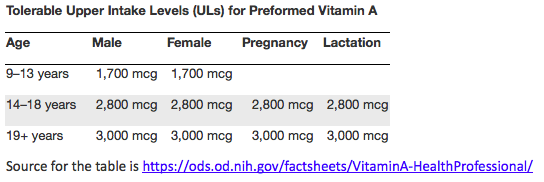The Recommended Dietary Allowance (RDA) for vitamin A is in retinol activity equivalents (RAE) to account for the different bioactivities of retinol and provitamin A carotenoids, all of which are converted by the body into retinol. The RDA is set to provide the average daily amount to meet the nutrient requirements of nearly all (97%–98%) healthy people.

What are the risks of too much Vitamin A?
Vitamin A is stored in the liver, and because it is fat soluble, excessive amounts can build up and lead to toxicity. Chronic high intakes of Vitamin A from supplements or food can lead to increased intracranial pressure, dizziness, nausea, headaches, skin irritation, pain in joints and bones, coma, and even death. The Tolerable upper Intake Level (UL) applies to the upper daily amount of Vitamin A from foods and supplements associated with an increased risk of liver toxicity. Unless your physician recommends otherwise, stay under the UL for the best health.

Find out more about Vitamin A!
- What is Vitamin A and What Does It Do?
- Sources of Vitamin A: Food vs Supplements (coming soon!)
By Lynn Grieger, RDN, CDCES, CPT, CHWC
Copyright foodandhealth.com, reprinted with permission.

